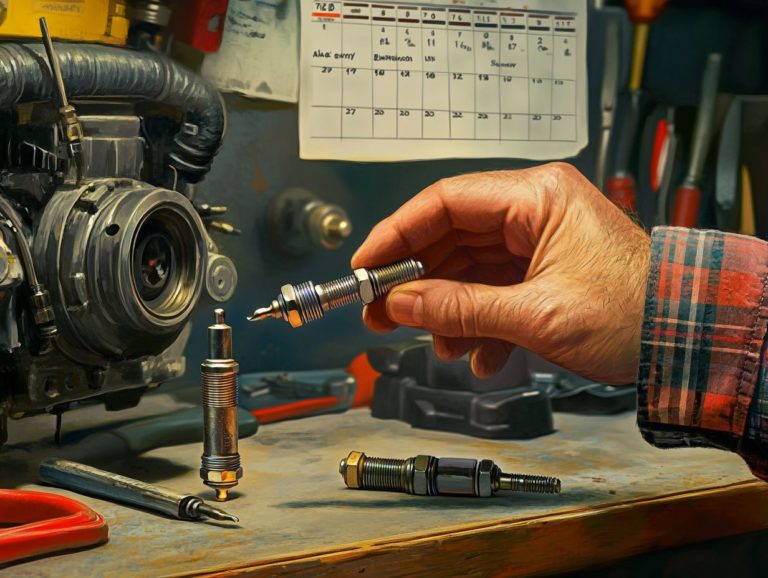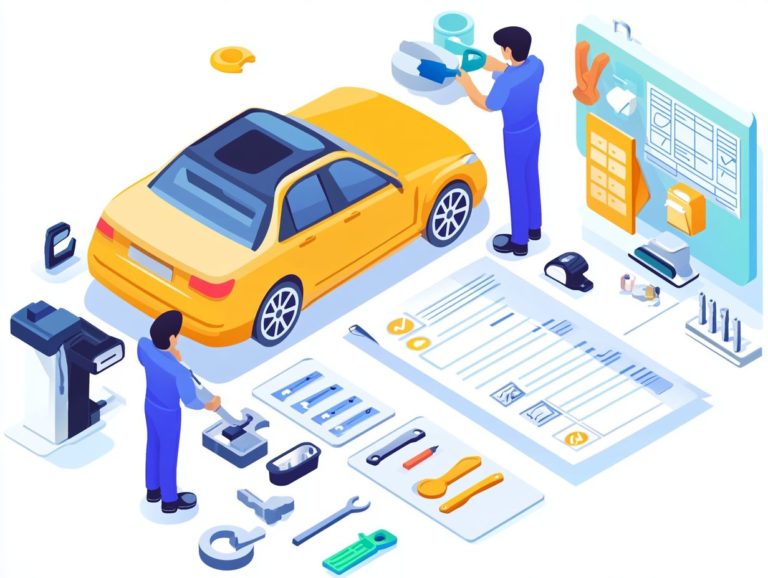Maintaining Your Car in Extreme Weather Conditions
Extreme weather presents significant challenges for drivers and their vehicles, making preparedness a necessity.
Whether you’re confronting snow, heavy rain, scorching heat, or biting cold, understanding how to maintain and protect your car is vital.
This article provides essential maintenance tasks, safe driving tips, and effective strategies to shield your vehicle from harsh conditions.
You will discover guidance on navigating specific weather scenarios along with advice for emergency situations.
Stay informed and ensure your car remains safe on the road!
Contents
- Key Takeaways:
- Preparing Your Car for Extreme Weather
- Driving in Extreme Weather
- Protecting Your Car from Extreme Weather
- Dealing with Specific Weather Conditions
- Emergency Situations and Roadside Assistance
- Frequently Asked Questions
- How can I prepare my car for extreme cold weather?
- What should I do to maintain my car during a heatwave?
- How can I protect my car from extreme weather conditions?
- What should I do if I get stuck in a snowstorm while driving?
- Can extreme weather conditions affect my car’s battery?
- What should I do to maintain my car’s interior during extreme weather conditions?
Key Takeaways:

- Regular maintenance is crucial for your car’s performance in extreme weather. Check fluids, tires, and brakes before the season hits.
- Adjust your driving habits to the weather conditions. Slow down, increase following distance, and use proper lighting and wipers.
- Protect your car from extreme weather by storing it in a garage or using a cover. Also, consider investing in weather-specific accessories.
Preparing Your Car for Extreme Weather
Preparing your car for extreme weather is vital for your safety and reliability, particularly in regions prone to severe conditions like tornadoes and flooding, such as Alberta and Longmont.
Proper vehicle maintenance is essential to keep your car in peak condition. This means regularly checking your battery, performing timely oil changes, and ensuring your tire pressure is up to par.
Investing in winter tires, inspecting your wiper blades, and making sure your HVAC system is functioning optimally can greatly enhance your ability to navigate through snow, rain, or those sweltering summer temperatures.
Essential Maintenance Tasks
Essential maintenance tasks for your vehicle encompass regular brake inspections, monitoring gas tank levels, and assembling an emergency kit to manage unforeseen situations.
Inspect your brake pads now to ensure your safety on the road. An emergency kit should include snacks and a reliable flashlight, preparing you for those long waits in unexpected circumstances. During the winter months, having traction aids readily accessible can significantly enhance your ability to navigate slippery roads safely.
These tasks not only keep your vehicle running smoothly but also grant you peace of mind during trips, regardless of the conditions you may encounter.
Driving in Extreme Weather
Driving in extreme weather presents unique challenges that demand specific vehicle safety strategies, especially when facing winter storms, torrential rain, or sweltering summer heat. Recognizing how to adjust your driving techniques can profoundly impact your ability to maintain control and ensure your safety on the road.
Whether you re using traction aids in snow or moderating your speed during heavy rainfall, preparation is essential to steering clear of accidents and navigating safely through adverse conditions.
Tips for Safe and Efficient Driving

For safe and efficient driving in extreme weather, regularly check your tire pressure, ensure your wiper blades are in top shape, and maintain your vehicle’s A/C system to handle those challenging temperature fluctuations.
Proper tire pressure isn t just a suggestion; it can significantly enhance your traction and fuel efficiency, particularly during rainy or icy conditions. When winter arrives, utilizing your defrosters will not only demist the windshield but also maintain optimal visibility.
As summer temperatures rise, don t forget to inspect your vehicle s air conditioning regularly. A well-functioning A/C system provides much-needed comfort and helps keep distractions at bay while you re behind the wheel. Consider investing in high-quality windshield wiper blades; they re essential for effectively clearing rain or snow, ensuring you maintain a clear line of sight on the road.
Don t wait for the next storm check your vehicle today!
Protecting Your Car from Extreme Weather
Protecting your car from extreme weather requires a thoughtful approach. Consider garage options and invest in high-quality car covers. These measures shield your vehicle from harsh conditions and extend its lifespan.
Equip your car with emergency supplies to be ready for unexpected situations during bad weather. By taking these precautionary steps, you can effectively prevent damage from elements like snow, rain, and intense sun exposure.
Garage and Cover Options
Choosing the right garage options and vehicle covers is crucial for safeguarding your car against harsh weather elements, including blazing sun, torrential rain, and heavy snow.
With many styles available, selecting the best option can feel overwhelming. A fully enclosed garage provides maximum protection from any weather condition, while a carport offers greater convenience for parking.
When it comes to vehicle covers, choose those crafted from durable, weather-resistant materials like polyester or specialized waterproof fabrics. These can effectively shield your car from harmful UV rays, heavy rainfall, and snow accumulation.
Breathable covers are a smart choice, as they prevent moisture from getting trapped underneath, which can lead to rust and damage. As you make your decision, consider features like reinforced seams and secure fastening mechanisms to ensure a snug fit.
With these measures, you can enjoy peace of mind, knowing your car is protected all year round!
Dealing with Specific Weather Conditions
Navigating specific weather conditions like snow, rain, heat, and cold demands tailored vehicle safety tips and thorough preparedness. Each of these weather scenarios presents distinct challenges that can impact your vehicle’s performance and driver control. It is crucial to understand the proactive measures available to you.
For instance, using traction aids can greatly enhance your vehicle’s performance in snowy conditions. Ensuring your Air Conditioning (A/C) is fully functional is essential during sweltering heat.
Snow, Rain, Heat, and Cold

When navigating through snow, rain, heat, or cold, following specific vehicle safety tips can significantly enhance your safety and performance on the road.
These weather conditions present various challenges. Staying proactive about vehicle maintenance ensures reliable operation no matter the scenario. For snowy drives, regular tire checks and switching to winter tires will improve traction. Using windshield wipers in rainy conditions greatly enhances visibility.
In extreme heat, keeping your coolant system in top shape is vital to prevent overheating. As temperatures drop, don t forget that battery checks become crucial, as cold weather can diminish battery performance.
By embracing these concise yet effective vehicle maintenance tips, you can navigate adverse conditions with confidence and peace of mind.
Emergency Situations and Roadside Assistance
In emergencies like breakdowns or accidents, having an emergency kit and knowing how to access roadside assistance are essential vehicle safety tips. These significantly enhance your safety and preparedness on the road.
Whether you encounter a flat tire, run out of gas, or face an unexpected accident, being equipped with the right supplies and knowledge can make a difference in effectively managing the situation.
Don t wait! Start protecting your vehicle today to ensure its longevity and your safety!
What to Do in Case of Breakdown or Accident
In the unfortunate event of a breakdown or accident, remain calm. Use your emergency kit while calling for roadside assistance to ensure your safety.
First, assess the situation. Check for any injuries and, if possible, move to a safe location away from traffic.
Once you re secure, retrieve emergency items like a reflective triangle, flares, or cones. These will improve visibility and alert other drivers.
If anyone is injured, use your first aid kit. Check your vehicle’s emergency tools as well.
Next, contact roadside assistance. Provide your location and a brief issue description. Keep your hazard lights on and stay inside your vehicle for protection until help arrives.
Frequently Asked Questions
How can I prepare my car for extreme cold weather?

To prepare your car for extreme cold, ensure your radiator has antifreeze and your engine uses winter-grade oil. Check your tires for proper inflation and consider switching to winter tires for better traction.
Keep an emergency kit in your car. Include a blanket, water, and non-perishable snacks.
What should I do to maintain my car during a heatwave?
Regularly check your car’s coolant levels and monitor your engine’s temperature gauge during a heatwave. Park in the shade or use a sunshade to avoid overheating.
Always keep an emergency water supply in your car.
How can I protect my car from extreme weather conditions?
Invest in a car cover to shield it from harsh elements like hail and snow. Apply a protective coating to your car s exterior to prevent damage from road salt.
Wash and wax your car regularly to maintain its appearance and protect it from weather damage.
What should I do if I get stuck in a snowstorm while driving?
Stay calm and if possible, move your car to the side of the road. Turn on your hazard lights and stay inside until the storm passes.
If you need to run the engine for heat, ensure the exhaust pipe is clear of snow to prevent carbon monoxide poisoning.
Can extreme weather conditions affect my car’s battery?
Extreme weather can significantly impact your car’s battery. Cold can drain the battery, while heat can cause corrosion.
To maintain your battery, keep it clean and regularly check its charge. Consider a battery warmer for cold weather or park in the shade when it’s hot.
What should I do to maintain my car’s interior during extreme weather conditions?
Use a sunshade to protect your dashboard and seats from heat damage. In cold weather, consider using seat warmers to keep the interior comfortable.
Regularly clean and condition the interior to prevent damage from salt and snow. Keep an emergency kit in your car, including a flashlight and extra blankets.






